 Last additions - Nagahama 長浜市 Last additions - Nagahama 長浜市 |
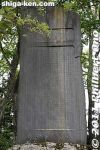
Can't read this.Jun 30, 2011
|
|
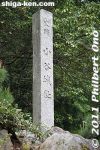
Marker for Odani Castle.Jun 30, 2011
|
|
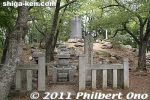
Within the Sakura-no-Baba is this memorial for the Azai clan.Jun 30, 2011
|
|
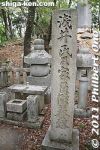
Memorial for the Azai clan in the Sakura-no-Baba. It's not a grave. Azai Nagamasa's grave (along with this father and grandfather's graves) is at Tokushoji temple in central Nagahama (photos at bottom).Jun 30, 2011
|
|

Illustration of Sakura-no-Baba Horse Grounds, seen on the slender terrace on the right, overlooking the Ouma-ya.Jun 30, 2011
|
|
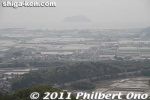
View from Sakura-no-Baba with Lake Biwa and Chikubushima island.Jun 30, 2011
|
|
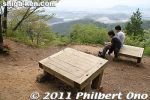
Sakura-no-Baba is also one of the best spots for scenic views atop Mt. Odani. These wooden "benches" are actually explanatory panels which never got completed.Jun 30, 2011
|
|
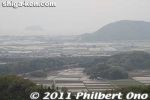
View from Sakura-no-Baba. Yamamoto-yama is on the right.Jun 30, 2011
|
|

About Sakura-no-Baba in Japanese.Jun 30, 2011
|
|
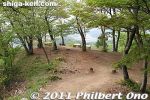
Sakura-no-Baba is between the Oumaya Horse Stable and the Ohiroma Hall.Jun 30, 2011
|
|
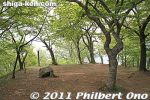
Sakura-no-Baba is where they filmed the scene in the NHK Taiga Drama "Go--Himetachi no Sengoku" when Nagamasa proposed marriage to Ichi.Jun 30, 2011
|
|
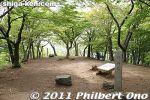
Now here is Sakura-no-Baba or Sakura Horse Grounds. This is one of the main highlights of Odani Castle due to its scenic views.Jun 30, 2011
|
|

Illustration of the Akao Yashiki residence.Jun 30, 2011
|
|

About the place where Azai Nagamasa committed seppuku and left behind his wife and three daughters who were allowed to escape.Jun 30, 2011
|
|
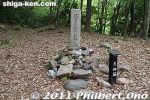
Stone marker indicating the place where Azai Nagamasa committed seppuku on Sept. 1, 1573 at age 29. Under siege by Nobunaga's forces, Nagamasa was unable to get back to the Honmaru and instead entered the Akao residence to cut his belly.Jun 30, 2011
|
|
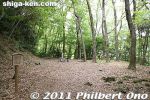
The Akao Yashiki residence was on a terraced area on the mountain slope near the foot of the Honmaru stone wall.Jun 30, 2011
|
|
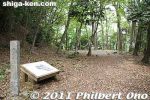
Marker for the Akao Yashiki residence. The Akao family was one of the Azai's important samurai retainers. The proximity of the residence to the Honmaru is indicative of this.Jun 30, 2011
|
|

About the Akao Yashiki residence.Jun 30, 2011
|
|
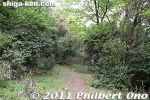
Short path to the Akao Yashiki residence. This was not part of the guided tour so I went here after the tour was over and stayed behind.Jun 30, 2011
|
|
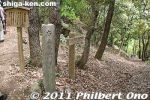
We soon came to the path leading to the Akao Yashiki residence where Azai Nagamasa committed suicide in the face of defeat by Oda Nobunaga in 1573.Jun 30, 2011
|
|

About the Head Display Stone in Japanese.Jun 30, 2011
|
|
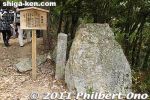
Head Display Stone is where Azai Sukemasa (first lord of Odani Castle) displayed the beheaded head of a traitor (Imai Hidenobu 今井秀信) among his samurai retainers in 1533. 首据石Jun 30, 2011
|
|
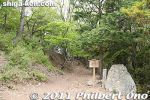
The next point of interest is a little more grisly. Jun 30, 2011
|
|
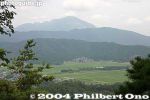
View of Mt. Ibuki from Mt. Odani.Jun 30, 2011
|
|
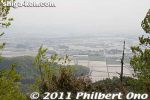
Jun 30, 2011
|
|
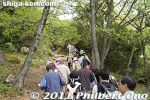
The tour was quite interesting. Our tour guide was a retired local person. It's too bad these tours would last only in 2011. It should be continued.Jun 30, 2011
|
|
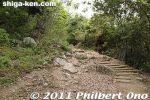
Some steps. Since the trail is not paved, it would get muddy on rainy days.Jun 30, 2011
|
|
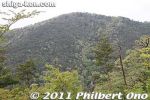
Peak of Mt. Odani as seen from the Ouma-ya.Jun 30, 2011
|
|
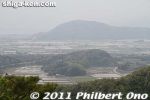
View from the Ouma-ya. That's Yamamoto-yama in the distance.Jun 30, 2011
|
|
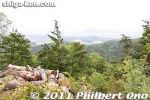
View from the Ouma-ya.Jun 30, 2011
|
|
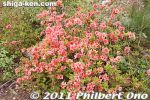
Azaleas blooming around the Horse Stable in May.Jun 30, 2011
|
|

Illustration of the Ouma-ya Horse Stable (center terrace). You can see the two Horse-washing Ponds at the foot of the stone wall.Jun 30, 2011
|
|

About the Horse Stable in Japanese.Jun 30, 2011
|
|
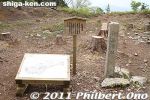
Site of the Ouma-ya Horse Stable. This castle keep was used to defend the castle's Honmaru keep. There was a water well in the center.Jun 30, 2011
|
|

Next to the Horse-washing Pond is a large area called the Ouma-ya or Horse Stable. It is not known if there actually was a horse stable here. This was enclosed on three sides by high earthen walls.Jun 30, 2011
|
|
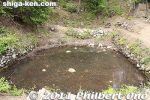
Horse-washing Pond. There were two ponds, this bottom one to wash off the main dirt and another pond behind this one on the upper level for cleaner washing. On the left was the Horse Stable. 馬洗池Jun 30, 2011
|
|

About the Horse Washing Pond and Horse Stable in Japanese.Jun 30, 2011
|
|
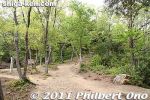
Jun 30, 2011
|
|
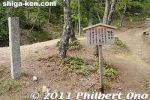
Jun 30, 2011
|
|
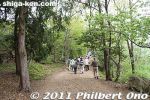
The trail is pretty level most of the way. It's not a strenuous tour.Jun 30, 2011
|
|

About the Ochaya in Japanese.Jun 30, 2011
|
|

Illustration of the Ochaya (on the lower left terrace). The area was divided into two by a dirt wall and had an L shape. It was a military outpost and included a small garden. 御茶屋跡Jun 30, 2011
|
|
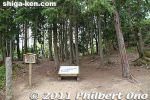
Site of the Ochaya which was right above the Bansho. It was Odani Castle's first castle keep or bailey within the castle's central area. 御茶屋跡Jun 30, 2011
|
|
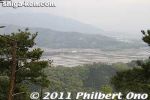
Jun 30, 2011
|
|
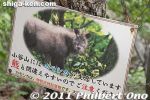
Beware of wild goats (kamoshika) on Mt. Odani.Jun 30, 2011
|
|
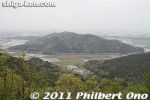
View of Mt. Toragozen (near Torahime Station on the JR Hokuriku Line) where Oda Nobunaga's troops were perched prior to their attack on Odani Castle in 1573.Jun 30, 2011
|
|
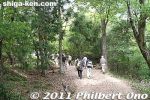
Walking further along the castle tour. The tour guide explained each site in Japanese with a megaphone. The tours were quite popular.Jun 30, 2011
|
|
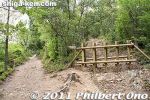
Trail blocked off.Jun 30, 2011
|
|

Illustration of Bansho guard house.Jun 30, 2011
|
|

About the Bansho in Japanese.Jun 30, 2011
|
|
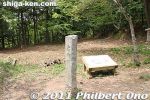
Bansho guard house site at Odani Castle. It was a security gate for castle visitors.Jun 30, 2011
|
|
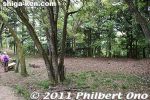
Bansho guard house siteJun 30, 2011
|
|
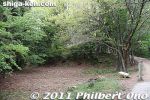
After a short walk was the Bansho guard house site here. 番所Jun 30, 2011
|
|

About the Kingo-maru keep in Japanese.Jun 30, 2011
|
|
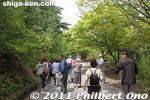
The shuttle bus goes almost halfway up Mt. Odani. We then got off the bus and walked as the tour guide led us. I went on this tour on my second visit to Odani Castle. Lot easier than the first time when I walked all the way from Kawake Station.Jun 30, 2011
|
|
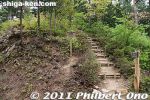
The first thing we saw was this, the Kingo-maru keep, a hill. Named after Asakura Norikage (Soteki) (朝倉 教景) who was stationed here while defending the castle against Rokkaku Takayori (六角高頼) in 1525.Jun 30, 2011
|
|

At the Odani pavilion at the foot of Mt. Odani, a shuttle bus with a bus guide is provided for 500 yen roundtrip during 2011. A lot easier than walking up the mountain.Jun 30, 2011
|
|
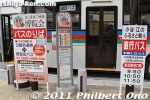
The shuttle bus leaves once or twice an hour from Nagahama Castle. It comes with a bus guide. Jun 30, 2011
|
|
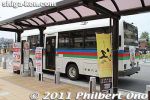
The 1,000 yen ticket includes admission to all three pavilions and roundtrip shuttle bus fare. Best to go the Odani pavilion first, then take another shuttle bus to Odani Castle.Jun 30, 2011
|
|
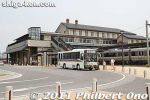
In 2011, the Go and Azai Sisters Expo was held in Nagahama. The west side of Nagahama Station had shuttle buses going to the Odani pavilion. Buy the roundtrip bus ticket at the little office near the bus stop at the train station.Jun 30, 2011
|
|

View of Lake Biwa and Chikubushima island from Mt. Odani.Jun 30, 2011
|
|
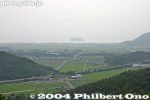
View of Lake Biwa and Chikubushima island.Jun 30, 2011
|
|
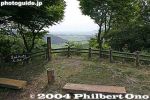
If you're walking up Mt. Odani, this is one of the best scenic viewpoints on Odani. Good place to rest too. Jun 30, 2011
|
|

Map of Mt. Odani and Odani Castle (National Historic Site). There is a series of castle keeps (maru) along the mountain ridge. Odani Castle was thus a yamajiro or mountain castle.Jun 30, 2011
|
|
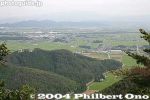
As you go higher up, the views get better.Jun 30, 2011
|
|
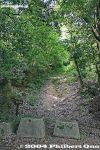
Otemichi path is apparently an alternate way up, but it is closed off to visitors.Jun 30, 2011
|
|
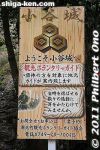
Welcome sign and phone No. for a volunteer tour guide. But even if you call, you have to make reservations and it makes no sense if you're already there.Jun 30, 2011
|
|
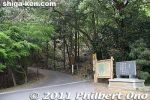
Road going up Mt. Odani. You can walk uphill (taking 30 min.), but easier if you have a car. I don't recommend walking up in the heat (and flying insects) of summer. MAPJun 30, 2011
|
|
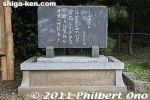
Jun 30, 2011
|
|

Map and history of Mt. Odani and Odani Castle, a National Historic Site. Odani Castle was built around 1523.Jun 30, 2011
|
|
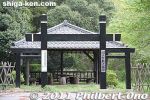
Rest house at foot of Mt. Odani.Jun 30, 2011
|
|
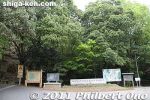
Entrance to the paved road going up the mountain. There's a small parking lot, small park, restrooms, and resthouse here.Jun 30, 2011
|
|
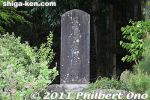
Odani Castle stone marker near the entrance to the paved road going up the mountain.Jun 30, 2011
|
|
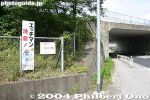
Warning sign for flashers.Jun 30, 2011
|
|
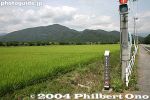
Mt. Odani in the distance. The first time I visited Odani Castle, I walked from Kawake Station. Took about 30 min. (2.4 km).Jun 30, 2011
|
|
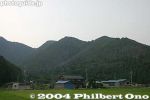
Mt. Odani has a series of peaks and the castle was built along the ridge. Odani Castle is one of Japan's five most famous mountain castles.Jun 30, 2011
|
|
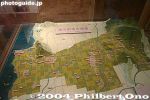
Inside Kawake Station is this model of the Odani area (formerly Kohoku town).Jun 30, 2011
|
|
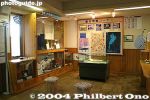
Inside Kawake Station.Jun 30, 2011
|
|
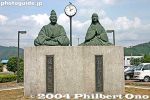
Outside Kawake Station is a statue of Lord Azai Nagamasa and wife Ichi who was Oda Nobunaga's younger sister. They lived in Odani Castle and had three famous daughters: Chacha, Hatsu, and Go.Jun 30, 2011
|
|
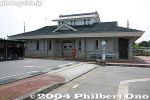
Kawake Station, on the JR Hokuriku Line, is the nearest train station to Odani Castle. There are buses from this station going to Odani Castle, but very few runs. Bicycles are available for rent though inside the station.More info on getting to Odani castle: https://shiga-ken.com/blog/2021/11/odani-castle-shuttle-buses/Jun 30, 2011
|
|

Jun 30, 2011
|
|

Jun 30, 2011
|
|

Jun 30, 2011
|
|

Drawings of the three Azai sisters by local children.Jun 30, 2011
|
|

Drawings of the three Azai sisters by local children exhibited in Heiwado in Nagahama.Jun 30, 2011
|
|
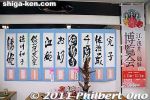
Calligraphy of Azai sisters-related words and phrases.Jun 30, 2011
|
|
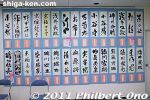
Calligraphy of Azai sisters-related words and phrases.Jun 30, 2011
|
|
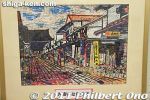
Jun 30, 2011
|
|
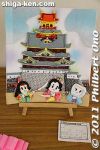
Odani Castle and the Azai sister trio.Jun 30, 2011
|
|
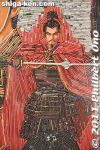
Oda NobunagaJun 30, 2011
|
|
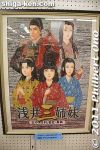
Splendid work of Azai sisters made of small rolls of paper.Jun 30, 2011
|
|
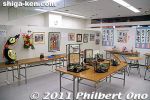
Top floor of Heiwado had this exhibition of Azai sisters-related crafts by local school children.Jun 30, 2011
|
|

Jun 30, 2011
|
|

Jun 30, 2011
|
|

Lots of Azai sisters merchandise on sale in Heiwado.Jun 30, 2011
|
|
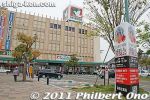
Heiwado dept. store in front of Nagahama Station.Jun 30, 2011
|
|
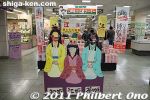
Inside Heiwado dept. store in front of Nagahama Station.Jun 30, 2011
|
|
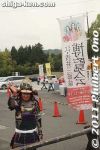
Woman dressed as Azai Nagamasa say Goodbye to the shuttle bus passengers.Jun 30, 2011
|
|
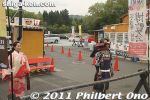
Whenever a shuttle bus comes and goes, two women dressed as Go and Azai Nagamasa say Welcome or Goodbye to the passengers.Jun 30, 2011
|
|
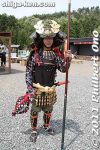
SamuraiJun 30, 2011
|
|

At the Odani pavilion at the foot of Mt. Odani, a shuttle bus to Odani Castle with a tour guide is provided for 500 yen roundtrip during 2011. A lot easier than walking up the mountain.Jun 30, 2011
|
|
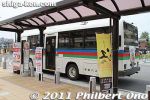
The 1,000 yen ticket includes admission to all three pavilions and roundtrip shuttle bus fare. Best to go the Odani pavilion first, then the Azai pavilion, and the central Nagahama pavilion on the way back.Jun 30, 2011
|
|
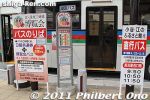
The shuttle bus leaves once or twice an hour. It comes with a bus guide.Jun 30, 2011
|
|
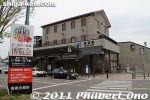
In 2011, the Go and Azai Sisters Expo is publicized everywhere in Nagahama. This is the east side of Nagahama Station.Jun 30, 2011
|
|
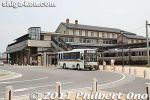
Go to the west side of Nagahama Station to catch the shuttle bus going to the Go and Azai Sisters Expo pavilions. Buy the roundtrip bus ticket at the little office near the bus stop at the train station.Jun 30, 2011
|
|

Shuttle bus to go to the next pavilion. They start from Nagahama Station's west exit and go to all three pavilions with stops at major attractions along the way. A bus guide is aboard the us.Jan 16, 2011
|
|
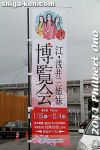
Go and Azai Sisters Expo banner.Jan 16, 2011
|
|

Gift shopJan 16, 2011
|
|
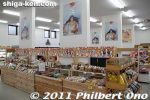
Inside the ift shop. This is the expo's largest gift shop. Buy your Azai sisters souvenirs and guide books here next to the Azai pavilion.Jan 16, 2011
|
|
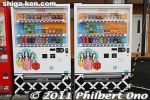
Vending machines with Azai sisters moif.Jan 16, 2011
|
|
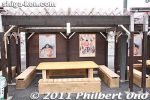
Table for food stalls.Jan 16, 2011
|
|
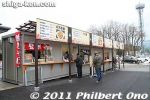
Food stallsJan 16, 2011
|
|

The Azai pavilion is called Azai–Go no Drama-kan (浅井・江のドラマ館). It displays kimono worn by the actresses (Ueno Juri, Miyazawa Rie) and samurai armor worn by the actors playing Oda Nobunaga and Azai Nagamasa. There’s also a small video Jan 16, 2011
|
|

About the Azai family sculpture. There's Nagamasa, Oichi, Chacha, Ohatsu Go, and Manpukumaru. They are gazing at Lake Biwa and Chikubushima from Odani.Jan 16, 2011
|
|
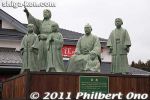
Statue of the Azai family in front of the Azai pavilion. As soon as they arrive here, most visitors take a picture of this sculpture.Jan 16, 2011
|
|
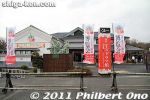
The third and main pavilion is in Azai. This is where the expo's opening ceremony was held on Jan. 15, 2011 with Shiga Governor Kada Yukiko and actor Tokito Saburo in attendance.Jan 16, 2011
|
|
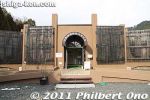
Odani Castle Sengoku Historical Museum. Admission 300 yen (not included in the expo ticket price). Can't take photos inside, but there are two small exhibition rooms explaining about the Azai clan and Odani Castle. No English.Jan 16, 2011
|
|
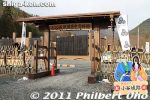
Entrance to Odani Castle Sengoku Historical Museum (小谷城戦国歴史資) opened in fall 2007. The museum is in the valley adjacent to Mt. Odani. Although the castle was atop the mountain, the castle lord and his family (Azai sisters) normally lived iJan 16, 2011
|
|
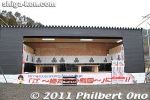
Outside the Odani pavilion is this outdoor stage. On weekends, a drama troupe performs.Jan 16, 2011
|
|
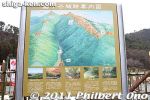
Map of Mt. Odani. From the Odani pavilion, there are shuttle buses going to Odani Castle. The roundtrip fare is 500 yen. It is a guided tour to the main parts of Odani Castle ruins. Photos here.Jan 16, 2011
|
|
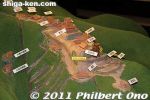
Model of Odani Castle. The mountain is quite steep and it was a difficult place to live logistically so normally, the castle lord and his family lived in the valley on the left side of the mountain.Jan 16, 2011
|
|
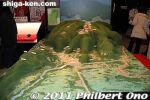
The Odani pavilion's most impressive exhibit was this scale model of Mt. Odani with Odani Castle in its heyday. On the left, you can also see Mt. Toragozen where Nobunaga's troops were perched to attack Odani Castle. Jan 16, 2011
|
|
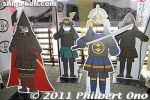
Jan 16, 2011
|
|
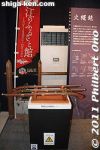
Also replica matchlock guns.Jan 16, 2011
|
|
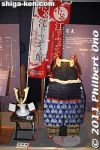
Inside the Odani pavilion is this samurai costume which you can wear and take pictures of yourself.Jan 16, 2011
|
|

Map of area surrounding the Odani pavilion.Jan 16, 2011
|
|
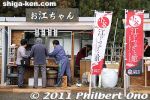
Food stall named "Ogo-chan."Jan 16, 2011
|
|
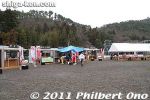
Outside the pavilion are food stalls and covered picnic tables.Jan 16, 2011
|
|
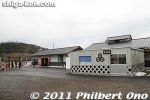
Rear view of Odani–Go no Furusato-kan (小谷・江のふるさと館) pavilion. The building in the foreground is a small gift shop.Jan 16, 2011
|
|
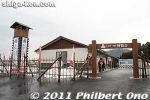
Odani–Go no Furusato-kan (小谷・江のふるさと館) in Odani. Jan 16, 2011
|
|
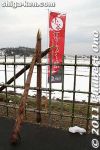
Jan 16, 2011
|
|
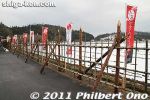
Fence modeled after a samurai battle fence.Jan 16, 2011
|
|
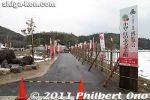
Path to the Odani pavilion called Odani–Go no Furusato-kan (小谷・江のふるさと館). Jan 16, 2011
|
|
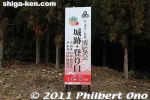
The Odani pavilion is at the foot of Odani Castle. Shuttle buses run between the three pavilions. Best to take a shuttle bus from Nagahama Station (West exit) and go directly to this pavilion.Jan 16, 2011
|
|
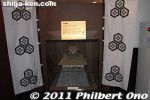
Photography is not allowed inside the pavilions except for certain objects. Model of Odani Castle. This pavilion next to the Hikiyama Museum does not have much. See it only if you have time or if you're a Taiga Drama fan.Jan 16, 2011
|
|
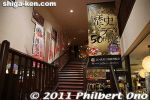
This pavilion is actually a small exhibition room on the 2nd floor of a small shopping complex. It has panel displays of past NHK Taiga Dramas (50 of them) and a small video theater.Jan 16, 2011
|
|
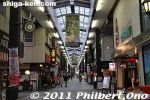
Otemon-dori shopping arcade in central Nagahama with banners showing the way to the Go and Azai Sisters Expo venue. The expo has three pavilions in three different locations: central Nagahama, Odani, and Azai.Jan 16, 2011
|
|
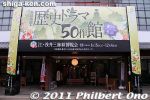
Across from the Nagahama Hikiyama Museum is the first Go and Azai Sisters Expo paviion called Nagahama Kurokabe Rekishi Drama 50-saku-kan (長浜黒壁・歴史ドラマ50作館).Jan 16, 2011
|
|

Kinomoto manhole, Shiga Pref.Feb 23, 2010
|
|

Feb 23, 2010
|
|

In front of the old Kinomoto Station.Feb 23, 2010
|
|

Inside old Kinomoto Station, apparently used as an occasional exhibition space.Feb 23, 2010
|
|

Old Kinomoto StationFeb 23, 2010
|
|

Old Kinomoto Station entrance and signFeb 23, 2010
|
|

Old Kinomoto Station which was used from 1936 to 2006. 旧木之本駅Feb 23, 2010
|
|

Old Kinomoto Station platformFeb 23, 2010
|
|

Old Kinomoto StationFeb 23, 2010
|
|

Train tracksFeb 23, 2010
|
|

Feb 23, 2010
|
|

Kinomoto Station as seen from the train.Feb 23, 2010
|
|

Kinomoto Station as seen from the train.Feb 23, 2010
|
|

Men's restroom made of wood. Very nice.Feb 23, 2010
|
|

CorridorFeb 23, 2010
|
|

First floor of station with tourist info counter and souvenir shop.Feb 23, 2010
|
|

2nd floor of station with ticket machine and turnstile.Feb 23, 2010
|
|

Front of station still under construction.Feb 23, 2010
|
|

Bicycle garage and new Kinomoto Station.Feb 23, 2010
|
|

The front plaza was still under construction in Jan. 2007. Feb 23, 2010
|
|

MuseumFeb 23, 2010
|
|

Feb 23, 2010
|
|

Feb 23, 2010
|
|

Feb 23, 2010
|
|

Feb 23, 2010
|
|

Feb 23, 2010
|
|

Feb 23, 2010
|
|

To Keisokuji temple, noted for fall leaves.Feb 23, 2010
|
|

Feb 23, 2010
|
|

Pond in front of ShakudojiFeb 23, 2010
|
|

There are a few walking paths next to Shakudoji. I walked on a path to see where it would take me.Feb 23, 2010
|
|

Feb 23, 2010
|
|

Shakudoji temple 石道寺Feb 23, 2010
|
|

Side view of Shakudoji templeFeb 23, 2010
|
|

Feb 23, 2010
|
|

Steps to Shakudoji templeFeb 23, 2010
|
|

About Shakudoji templeFeb 23, 2010
|
|

Front of Shakudoji templeFeb 23, 2010
|
|

Shakudoji temple marker. MAPFeb 23, 2010
|
|

Way to Shakudoji templeFeb 23, 2010
|
|

Ohofura Jinja Shrine toriiFeb 23, 2010
|
|

明楽寺Feb 23, 2010
|
|

Ohofura Jinja ShrineFeb 23, 2010
|
|

Myorakuji Temple in Kinomoto being renovated in 2007. Designated as National Tangible Cultural Property in spring 2023. 明楽寺 国の登録有形文化財Feb 23, 2010
|
|

Stone on which Rennyo sat in the 15th century. It felt comfortable enough.Feb 23, 2010
|
|

Myorakuji Temple in Kinomoto. 明楽寺Feb 23, 2010
|
|

Myorakuji Temple in Kinomoto. 明楽寺Feb 23, 2010
|
|

Site of Kinomoto-juku's Honjin along the Hokkoku Kaido road south of Jizo-in. 本陣跡Feb 23, 2010
|
|

Looks very traditional except for the car.Feb 23, 2010
|
|

Site of Kinomoto-juku's Honjin. 本陣跡Feb 23, 2010
|
|

Old-style mailbox and road marker.Feb 23, 2010
|
|

Feb 23, 2010
|
|

Hokkoku Kaido bannerFeb 23, 2010
|
|

Site of horse sale.Feb 23, 2010
|
|

Feb 23, 2010
|
|

Area where horses were sold.Feb 23, 2010
|
|

Photo op for tourists, where Kazutoyo bought his famous horse.Feb 23, 2010
|
|

Horse market 木之本牛馬市跡Feb 23, 2010
|
|

Feb 23, 2010
|
|

Former horse seller.Feb 23, 2010
|
|

Feb 23, 2010
|
|

Area where horses were sold and where Lord Yamauchi Kazutoyo's wife Chiyo bought a fine horse. The home on the left has an Udatsu slat (white) うだつFeb 23, 2010
|
|

Building on Jizo-zaka which was later torn down.Feb 23, 2010
|
|

Hokkoku Kaido goes to the Hokuriku region. MAPFeb 23, 2010
|
|

Hokkoku Kaido road going through post town Kinomoto-juku 北国街道Feb 23, 2010
|
|

Feb 23, 2010
|
|

Seated Kannon statue inside Kannon-do Hall. The hall is not normally open, so permission is needed to view it. 木造聖観音坐像 Jan 12, 2010
|
|

Jan 12, 2010
|
|

Jan 12, 2010
|
|

Kannon-do Hall housing a seated Kannon statue. 観音堂Jan 12, 2010
|
|

Jan 12, 2010
|
|

Gansan DaishiJan 12, 2010
|
|

Gansan DaishiJan 12, 2010
|
|

Gansan DaishiJan 12, 2010
|
|
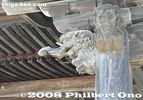
Gansan Daishi entered the priesthood at age 17 on Mt. Hiei's Enryakuji temple. In 966, he became the 18th head priest of the Tendai Sect at Enryakuji.Jan 12, 2010
|
|

Gansan Daishi belfryJan 12, 2010
|
|

Gyokusenji is a Buddhist temple of the Tendai Sect, commonly called Gansan Daishi, after the priest Gansan Daishi 元三大師 (912-985) whose birthplace is near the temple. MAPJan 12, 2010
|
|

Gansan Daishi temple, the current Hondo main hall was reconstructed in 1780.Jan 12, 2010
|
|

Gomura Betsuin belfryJan 12, 2010
|
|

Gomura Betsuin Gate. The Hondo main hall was reconstructed in 1730 and the front gate was built in 1674. MAPJan 12, 2010
|
|

Gomura Betsuin, Hondo Main Hall. Torahime's most noted sight and an Important Cultural Property is a Buddhist temple of the Jodo Shinshu Sect's Otani School (Higashi Hongwanji).Jan 12, 2010
|
|

Gyokusenji or Gansan Daishi temple 玉泉寺Jan 12, 2010
|
|

Torahime manhole, Nagahama, Shiga Pref.Jan 12, 2010
|
|

Mt. Ibuki can be seen from almost everywhere in Torahime.Jan 12, 2010
|
|

Jan 12, 2010
|
|

Front entrance to Torahime High School, one of Shiga's most excellent schools, boasting Shiga's highest rate of college-bound students.Jan 12, 2010
|
|

Torahime High School in the distance, next to rice paddies.Jan 12, 2010
|
|

Jan 12, 2010
|
|

Jan 12, 2010
|
|

Jan 12, 2010
|
|

Jan 12, 2010
|
|
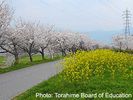
Cherry blossoms along the Kasumitei riverbank.Jan 12, 2010
|
|

Monument marking the site of Lord Yamauchi Kazutoyo's first fief which was in Torahime.Jan 12, 2010
|
|

Jan 12, 2010
|
|

Mt. Ibuki and a "tiger stripe" barrel.Jan 12, 2010
|
|

Takawa River 田川Jan 12, 2010
|
|

Takawa River 田川Jan 12, 2010
|
|

Umahashi Bridge うまはしJan 12, 2010
|
|

Roadside shrineJan 12, 2010
|
|

Main drag of TorahimeJan 12, 2010
|
|

Tourist map of TorahimeJan 12, 2010
|
|

Tiger Princess statue Jan 12, 2010
|
|

Tourist map of TorahimeJan 12, 2010
|
|

"Torahime Tiger Princess, the Goddess of Victory"Jan 12, 2010
|
|

Tiger Princess statue outside the Torahime StationJan 12, 2010
|
|

New event space called "Coco," opened in March 2008, across from Torahime StationJan 12, 2010
|
|

Bicycle parking at Torahime StationJan 12, 2010
|
|

Inside the Italian restaurant at Torahime Station.Jan 12, 2010
|
|

Be photographed as a Tiger PrincessJan 12, 2010
|
|

In Oct. 2005, some people came here to pray for Osaka's Hanshin Tigers baseball team to win the Japan Series against the Chiba Lotte Marines who later won the series in a four-game sweep. The Tigers never won a game in the series.Jan 12, 2010
|
|

Tiger Princess Shrine at Torahime Station. (Torahime literally means "Tiger Princess.")Jan 12, 2010
|
|

Jan 12, 2010
|
|

Built in a loghouse-style. All wood.Jan 12, 2010
|
|

Torahime StationJan 12, 2010
|
|
| 3007 files on 12 page(s) |
 |
 |
6 |  |
 |
|